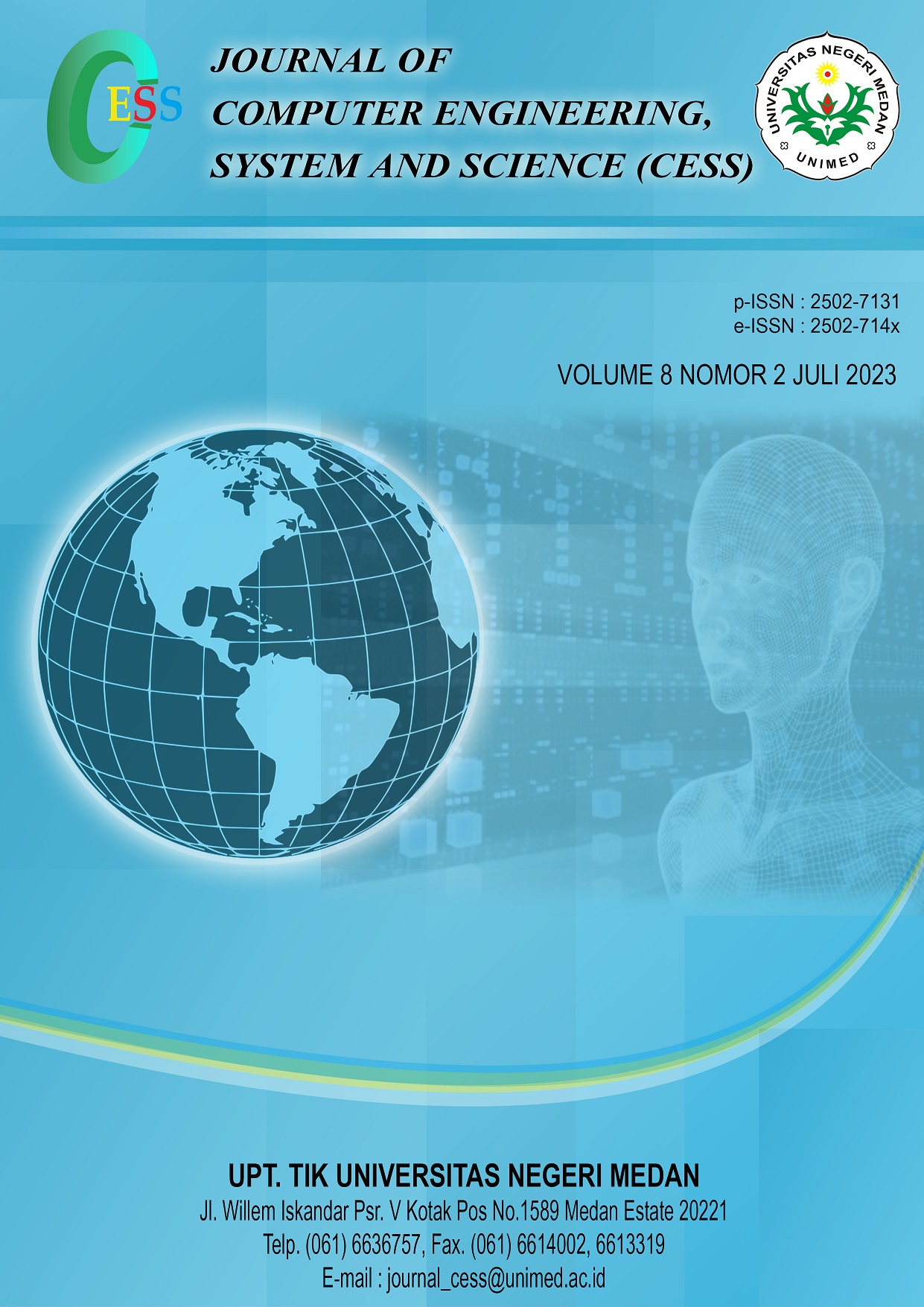Analysis of Undiksha E-Learning User Satisfaction Using the End-User Computing Satisfaction (EUCS) Method
DOI:
https://doi.org/10.24114/cess.v8i2.48161Keywords:
user satisfaction, E-Learning, EUCS method, improvementsAbstract
Penelitian ini bertujuan untuk mengoptimalkan sistem E-Learning Universitas Pendidikan Ganesha (Undiksha) dengan meminimalisir dampak negatif yang terkait, seperti mata lelah, kurangnya interaksi sosial, dan kurangnya pemahaman terhadap materi pembelajaran. Metode End-User Computing Satisfaction (EUCS) digunakan untuk mengukur tingkat kepuasan pengguna, yaitu mahasiswa Program Studi Ilmu Komputer, Program Pascasarjana, Undiksha, terhadap sistem E-Learning yang ada. Data penelitian dikumpulkan melalui kuesioner yang diisi oleh mahasiswa dan kemudian dianalisis untuk mengidentifikasi area-area yang memerlukan perbaikan dalam sistem E-Learning. Selain itu, faktor-faktor teknis dan struktural juga dipertimbangkan dalam penelitian ini. Hasil penelitian menunjukkan evaluasi isi berada di angka 3,4175, akurasi di angka 4, bentuk di angka 4,165, ketepatan waktu di angka 3,93 dan kemudahan penggunaan adalah 3,905. Dari hasil tersebut secara keseluruhan tingkat kepuasan pengguna berada di nilai rata-rata sebesar 3,8835 yang berada pada level 3 (Setuju). Hal ini menunjukkan bahwa pengguna sistem yang disediakan oleh Universitas memenuhi kebutuhan dan memberikan pengalaman yang positif dalam pengoperasian platform tersebut. Disarankan agar Undiksha meningkatkan sistem E-Learning untuk mencapai rentang nilai yang lebih tinggi dalam evaluasi kepuasan pengguna di masa depan, sambil memberikan rekomendasi bagi peneliti selanjutnya untuk mengembangkan kuesioner dengan indikator yang lebih optimal sesuai dengan konteks penelitian.This research aimed to optimize the E-Learning system of Universitas Pendidikan Ganesha (Undiksha) by minimizing the associated negative impacts, such as eye strain, lack of social interaction, and inadequate understanding of the learning materials. The End-User Computing Satisfaction (EUCS) method was used to measure the satisfaction level of users, specifically the students of the Computer Science of Graduate Programs at Undiksha, towards the existing E-Learning system. Research data was collected through questionnaires filled out by students and then analyzed to identify areas that require improvement in the E-Learning system. Additionally, technical and structural factors were also considered in this study. The research results show that the content evaluation, accuracy, format, timeliness, and ease of use were at 3.4175, 4, 4.165, 3.93, and 3.905, respectively. From these results, the overall level of user satisfaction was at an average value of 3.8835 which was at level 3 (Agree). This indicates that the users find the system provided by the university to meet their needs and provide a positive experience in operating the platform. It is recommended that Undiksha improves the E-Learning system to achieve a higher range of values in future user satisfaction evaluations while providing recommendations for further researchers to develop a questionnaire with more optimal indicators according to the research context.Downloads
References
Y. Bellarhmouch, A. Jeghal, H. Tairi, and N. Benjelloun, œA proposed architectural learner model for a personalized learning environment, Educ Inf Technol (Dordr), vol. 28, no. 4, pp. 4243“4263, Apr. 2022, doi: 10.1007/S10639-022-11392-Y/FIGURES/5.
G. Ngurah, S. Wijaya, W. K. Suwastika, œAnalisis Kepuasan Pengguna Elearning Menggunakan Metode End-User Computing Satisfaction, E-Proceedings KNS&I STIKOM Bali, pp. 558“562, Aug. 2017, Accessed: Jun. 29, 2023. [Online]. Available: https://knsi.stikom-bali.ac.id/index.php/eproceedings/article/view/102
D. Al-Fraihat, M. Joy, R. Masa™deh, and J. Sinclair, œEvaluating E-learning systems success: An empirical study, Comput Human Behav, vol. 102, pp. 67“86, Jan. 2020, doi: 10.1016/J.CHB.2019.08.004.
K. Ayu and S. R. Oktaviana, œAnalisis Kepuasan Masyarakat Kota Depok Terhadap Penggunaan Aplikasi Depok Single Window dengan Menggunakan EUCS Depok City Community Satisfaction Analysis on the Use of Depok Single Window Application Using EUCS, 2022.
N. Hidayati, œSistem E-Learning untuk Meningkatkan Proses Belajar Mengajar: Studi Kasus pada SMA Negeri 10 Bandar Lampung, Telematika MKOM, vol. 2, no. 2, pp. 153“170, Jul. 2016, doi: 10.36080/TELEMATIKAMKOM.171.
H. Henderi, M. Maimunah, and R. Andrian, œDesain Aplikasi E-Learning sebagai Media Pembelajaran Artificial Informatics, CCIT (Creative Communication and Innovative Technology) Journal, vol. 4, no. 3, pp. 316“330, May 2011, doi: 10.33050/CCIT.V4I3.453.
I. Sopiandi, œKepuasan Pengguna Media Aplikasi Interaktif Berbasis E-Learning di Universitas Majalengka, SMARTICS Journal, vol. 3, no. 2, Oct. 2017, doi: 10.21067/smartics.v3i2.2169.
I. Purwandani, œAnalisa Tingkat Kesiapan E-Learning (E-Learning Readiness). Studi Kasus: AMIK Bina Sarana Informatika Jakarta, Online, 2017.
W. J. Doll and G. Torkzadeh, œThe Measurement of End-User Computing Satisfaction, MIS Quarterly, vol. 12, no. 2, pp. 259“274, 1988, [Online]. Available: http://www.jstor.org/stable/248851
W. Doll, X. Deng, T. Ragu-Nathan, G. TORKZADEH, and W. Xia, œThe Meaning and Measurement of User Satisfaction: A Multigroup Invariance Analysis of the End-User Computing Satisfaction Instrument, J. of Management Information Systems, vol. 21, pp. 227“262, Jun. 2004, doi: 10.1080/07421222.2004.11045789.
N. L. Rachmawati and K. Dwi, œEvaluasi Kepuasan Pengguna Sistem E-Learning Menggunakan Metode End-User Computing Satisfaction. Studi Kasus: Universitas Amikom Purwokerto, Journal of Information System Management (JOISM), vol. 3, no. 1, pp. 1“7, Jul. 2021, doi: 10.24076/joism.2021v3i2.473.
D. Ridley, The literature review: a step-by-step guide for students, 2nd ed. in SAGE study skills. London: SAGE, 2012.
A. Fitriansyah, A. Fitriansyah, and I. Harris, œPengukuran Kepuasan Pengguna Situs Web dengan Metode End-User Computing Satisfaction (EUCS), Query: Journal of Information Systems, vol. 2, no. 1, p. 1, Apr. 2018, doi: 10.58836/query.v2i1.1552.
M. Schrepp, J. Thomaschewski, and A. Hinderks, œConstruction of a Benchmark for the User Experience Questionnaire (UEQ), International Journal of Interactive Multimedia and Artificial Intelligence, vol. 4, no. 4, pp. 40“44, Jun. 2017, doi: 10.9781/ijimai.2017.445.
A. Suharsimi, Metodologi Penelitian: Tuntunan Praktis untuk Mendapatkan Ilmu yang Berharga. Rajawali Pers, 2017.
Downloads
Published
How to Cite
Issue
Section
License
Copyright (c) 2023 CESS (Journal of Computer Engineering, System and Science)

This work is licensed under a Creative Commons Attribution 4.0 International License.















